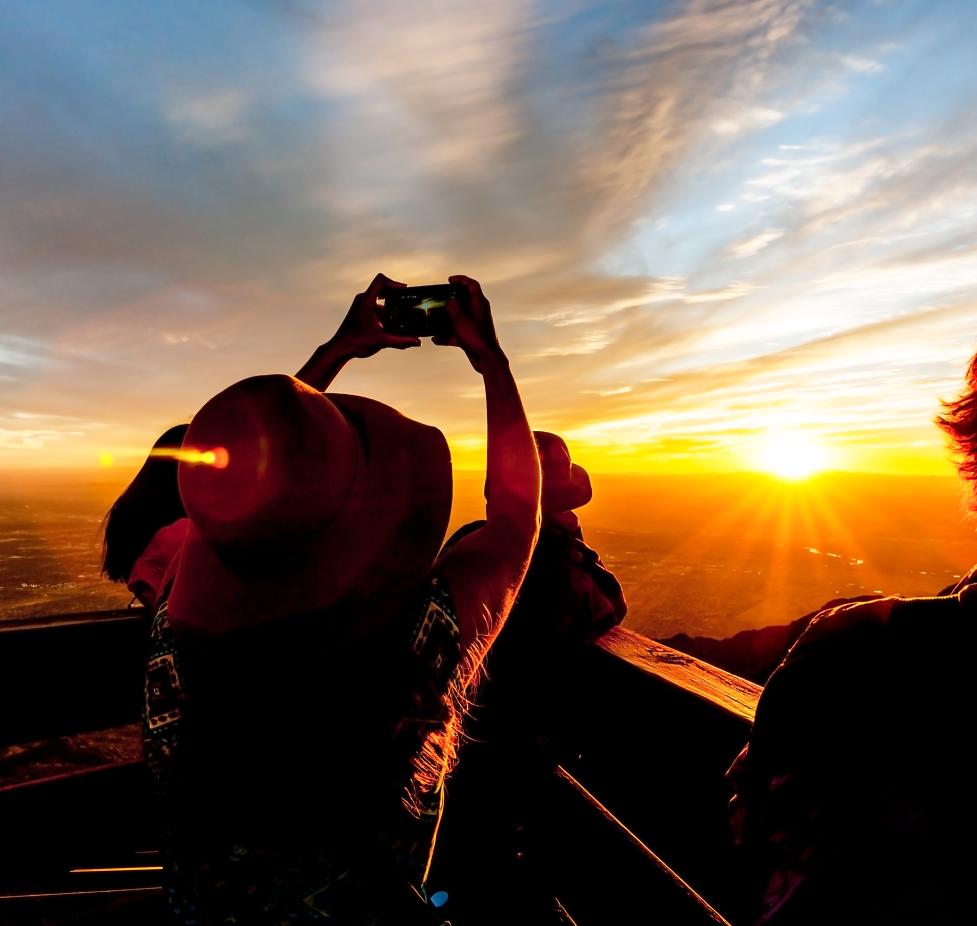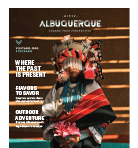Visit Albuquerque prohibits users from downloading images from our website.
Please use our media library for downloadable images and usage rights.
See More in this Section:
OVERNIGHT TRIPS
New Mexico and the surrounding western states offer unparalleled scenery, fascinating cultural history and beautiful weather.
To find your route, see Maps: Regional Maps
- Northwest New Mexico
Travel through Indian Country including several national monuments and beautiful scenery. - North Central New Mexico
Explore Taos, the Enchanted Circle, Georgia O'Keefe country and the Jemez Mountains. - Northeast New Mexico
Discover the Santa Fay Trail, several historic and wildlife sites and see the nation's largest mountain, Sierra Grande. Several scenic byways run through this area as well as state parks and many museums. - Southwest New Mexico
Wildlife abounds at the Sevilleta National Wildlife Refuge, Bosque del Apache and Gila National Forest. Immerse yourself in history at an old mining town or at the Gila Cliff Dwellings National Monument. - Southeast New Mexico
Trek through the otherworldly landscape of White Sands National Monument, explore historic Billy the Kid country and look for bats at Carlsbad Caverns National Park.
Northwest New Mexico
1. Sky City and Beyond
Snowcapped peaks and multicolored bluffs form the backdrop for a tour of the rich cultural and natural history of Northwestern New Mexico. The Route 66 Historic Trail leads west past the Pueblo of Laguna and Acoma (Sky City, which sits atop a solitary mesa) both Pueblos have well-preserved mission churches. Grants--which has been a railroad camp, carrot-farming community and uranium-mining town--is home to the New Mexico Mining Museum and is the gateway to El Malpaís National Monument, an ancient lava flow and National Natural Landmark. Unique geologic features of the area include La Ventana natural arch, an ice cave and Bandera Crater. At El Morro National Monument, generations of soldiers, travelers and traders left their marks on Inscription Rock.
2. Toward the Four Corners
Traveling along the state's western edge, you'll be in the heart of Indian Country, which is why this road is included in New Mexico's Native Heritage Trail system of scenic byways. Zuni Pueblo is famous for its silver and turquoise jewelry; permission is required to visit the ruins at Hawikuh and the Village of the Great Kivas. Gallup, a major trading center for Native American arts, hosts tribal ceremonial events throughout the year. The Red Rock Museum chronicles local history from the Ice Age to the present. Driving north through the Navajo Reservation, you'll pass remarkable rock formations culminating with Shiprock Pinnacle. Take the Chuska Mountains Red Lake Auto Tour and stand in four states at once at the Four Corners Monument.
3. Northern River Journey
This area on the edge of the Navajo Reservation is an outdoorsman's paradise and history buffs won't be disappointed either. Farmington is known as Totah, or "meeting place of the waters," because the Animas and La Plata Rivers empty into the San Juan River here; they provide some of the best fishing in the state. The Totah Festival is held here each September. East of town, you can hike among ancient Anasazi ruins at Aztec Ruins National Monument and Salmon Ruins; Heritage Park recreates human habitation in the San Juan Valley over thousands of years. Three marinas at Navajo Lake provide access for boating and fishing.
4. Time and the Elements
Civilization flourished atop the mesas here for hundreds of years; before that, prehistoric sharks swam in an inland sea. This route connects both eras to the present day. Travelers heading south from Farmington will come upon the Bisti/De-Na-Zin Wilderness first. The eerie mushroom-shaped rocks you'll see here were once underwater, and fossils abound. Just a few miles away is Chaco Canyon; between AD 850 and 1250 it was a major political, economic and religious center; the Chaco Culture National Historical Park preserves its legacy. On your way back toward Grants, stop in Crownpoint for exquisite Navajo woven rugs.
North Central New Mexico
1. High Road to Taos
Take time to explore Pueblos and Hispanic farming villages along this winding road. East of Española is the historic Santa Cruz Pueblo Plaza. Experience sacred history at El Santuario de Chimayó and woolen works of art at the Ortega Weaving Compound. You'll find more galleries and shops in Truchas and Cordova, and a pottery studio in Ojo Sarco. Picuris Pueblo is also famous for pottery and the church in Trampas was recently restored. In Taos, visit the Harwood Foundation Museum, the Kit Carson Home or the Millicent Rogers Museum.
2. The Enchanted Circle
Skiers will be extra enchanted by this forested byway around New Mexico's tallest mountain, Wheeler Peak. The Rio Grande Gorge Bridge, one of the nation's highest, is a short drive west of El Prado. Visit the D. H. Lawrence Ranch and Shrine near San Cristobal, or head north to explore the Wild Rivers Natural Recreation Site. Between the year-round resorts of Red River and Eagle Nest you'll pass the ghost town of Elizabethtown. Angel Fire boasts great ski runs and hiking trails, plus breathtaking views at the DAV Vietnam Veterans Memorial.
3. High Desert Waters
The Rio Grande leads you south again from Taos toward the natural hot springs of Ojo Caliente. Up for a little adventure? Stop in Pilar and try whitewater rafting. Embudo is a great spot for lunch along the river, and in fall the apple orchards and wineries around Dixon may tempt you to stock up. Learn about the area's history at the Oñate Monument Visitor Center, or explore the picturesque villages of Velarde and Alcalde. Then continue south to Santa Fe or turn north again for a relaxing soak.
4. Abiquiu Adventure
Don't be surprised if it looks like a Georgia O'Keeffe painting; many of her most famous works were inspired by the scenery and landscapes here. O'Keeffe spent many years at Ghost Ranch, which now houses a refuge for injured native wildlife. Nearby Abiquiu Lake is a popular boating spot, as are Heron and El Vado Lakes farther north. Echo Canyon Amphitheater and Christ-in-the Desert Monastery are stunning environments for quiet contemplation. Tierra Wools features local wool and unique weavings, and Chama visitors can ride the Cumbres & Toltec Scenic Railroad.
5. Jemez Mountain Trail
The highway west from Los Alamos leads to a rugged landscape of red rocks and pines. At Bandelier National Monument, explore wooded trails and ancient cliff dwellings. Farther west is Valle Grande, a wide grassland formed by a long-ago volcano. Jemez Springs is home to a monastery, the remains of a 17th-century church, and of course, hot springs. Take a dip among natural rock formations like Soda Dam and Battleship Rock. Jemez Pueblo holds crafts fairs at Red Rock State Park and San Ysidro has its own fine galleries.
Northeast New Mexico
1. The Santa Fe Trail
A colorful history is hidden in wagon ruts beneath tall prairie grasses; all you have to do is look for it. The Pecos National Historical Park (an abandoned mission) provides a good introduction. The Las Vegas area boasts nearly 1,000 historical sites, including the Rough Riders Memorial and Montezuma Castle--plus a National Wildlife Refuge. Head north to Storrie Lake State Park, the La Cueva National Historical Site, Salman Ranch and the Cleveland Roller Mill near Mora. The Fort Union National Monument marks a Civil War site, and the Wagon Mound was the last great landmark on the Trail. Boy Scouts at the Philmont Scout Ranch share the area with a variety of parks and wildlife areas and the NRA Whittington Center is a state-of-the-art shooting facility.
2. Along the Dry Cimarron
Historical sites and fascinating landscape make the Dry Cimarron Scenic Byway a fun and educational trip for the whole family. The Raton Museum commemorates the miners, railroaders and cattlemen of the 1800s, and at Sugarite Canyon State Park you can camp, hike and fish at an old mining camp. The Folsom Man Archaeological Site yields evidence of human habitation 10,000 years ago. A detour south takes you to the Capulin Volcano National Monument and the nation's largest single mountain, Sierra Grande. Natural wonders abound on the road east, including Folsom Falls, Toll-Gate Canyon, the Travesser Overlook, the Battleship and Wedding Cake Butte, before you head south to Clayton.
3. Prairie Pioneers
Follow the Santa Fe Trail's Cimarron Cutoff through the high prairies of northeastern New Mexico. Start in Springer with historical exhibits at the Santa Fe Trail Museum and the Livery Stable; then head east, across the Canadian River and north of the Kiowa National Grassland. This was once fertile farmland; now little remains except the ruined Mills Canyon Hotel and the Dorsey Mansion. Near Clayton, you can see dinosaur tracks preserved at Clayton Lake State Park, walk the National Grassland Hiking Trail, and visit the Herzstein Memorial Museum and the Union County Historical Park.
4. Touring the Mesalands
The Mesalands Scenic Byway loops among colorful rock formations and clear, cool lakes, with stops on old Route 66. Scuba dive in Santa Rosa's famed Blue Hole or visit the site of Coronado's Bridge near Puerto de Luna. Then head east along the red sandstone cliffs known as the Caprock, and north to Tucumcari, home of the Tucumcari Historical Museum and the Mesalands Dinosaur Museum. On your return, you can fish, swim and windsurf at three state parks: Ute Lake, Conchas Lake and Santa Rosa Lake.
Southwest New Mexico
1. Science and Nature
State-of-the-art research facilities share the mesas with native wildlife, attesting to New Mexico's science history. The Sevilleta National Wildlife Refuge is one of the nation's largest. Stroll around historic Socorro Plaza and check out the Mineral Museum while you're in town. Head west to science centers like the Magdalena Ridge Observatory, Langmuir Lightning Research Lab and the Very Large Array. Hike and learn history at the Datil Well National Recreation Site, then continue through two national forests to end in the Old West town of Reserve.
2. Rio Grande Valley Tour
Two-lane roads follow the course of the river, so travelers who want to avoid the highway can explore at their leisure. The Quebradas National Backcountry Byway loops out through the badlands, and the Bosque del Apache National Wildlife Refuge is a stopover for migrating birds. Study the region's past at Fort Craig and the Camino Real Heritage Center. Camp at Elephant Butte Lake or soak in the hot springs of Truth or Consequences; visit the Geronimo Springs Museum too. Fort Selden State Monument recreates fort life on summer weekends.
3. Geronimo Trail and the Outer Loop
Silver and gold lured fortune seekers here in the late 1800s; today's adventurers come for mountain vistas and scenic villages. Take the Geronimo Trail Scenic Byway to the pecan groves of Cuchillo, then continue to the mining towns of Winston and Chloride (which has a Pioneer Museum). This route includes gravel roads (check trailer lengths) leading to the seclusion of the Gila Wilderness and Snow Lake. Return to civilization at the ghost town of Mogollon; visit the Glenwood State Fish Hatchery and walk the Catwalk National Recreation Trail.
4. Trail of the Mountain Spirits
Leave the desert behind as you climb among the tall pines and rocks of the Gila National Forest. The tin-roofed towns of Hillsboro and Kingston mark mining country, as does a mile-wide copper mine at Santa Rita. House-size boulders litter City of Rocks State Park south of Fort Bayard. Tour the Victorian homes of Silver City and visit its two museums and the nearby town of Pinos Altos. Fish and swim at Lake Roberts and marvel at the Mogollón ruins of Gila Cliff Dwellings National Monument.
5. North of the Border
Here the highway retraces an old stagecoach route, leading from the Organ Mountains west to the Mesquite Hills. Dripping Springs offers an oasis between visits to the Farm and Ranch Heritage Museum, Old Mesilla and more. Sample local wines at the Saint Clair Winery and minerals at Rockhound State Park and the Geolapidary Museum. Pancho Villa State Park commemorates the Mexican War, while the Lordsburg Museum documents more regional history. Then head out to the Shakespeare and Steins ghost towns or north to the Red Rock Wildlife Management Area.
Southeast New Mexico
1. Up and Away
From dazzling dunes to snowy peaks to space exploration, this route is a study in New Mexican contrasts. The White Sands Missile Range Museum documents early rocket research at nearby White Sands National Monument; farther north, you can tour the Dunes Drive and hike the Interdune Boardwalk. Trinity Site is open the first Saturdays of April and October. In Alamogordo, see exhibits at the New Mexico Museum of Space History and a film at the IMAX Dome Theater, then drive the Sunspot Scenic Byway to the National Solar Observatory and Apache Point Observatory or ski at Cloudcroft
2. Billy the Kid Country
Many New Mexico communities lay claim to Billy the Kid, but this area witnessed some of his most infamous exploits. Past Tularosa's pistachio farms and vineyards, you cross the Lincoln National Forest en route to Ruidoso, where you can catch a show at the Spencer Theater for the Performing Arts or visit the Hubbard Museum of the American West. Take a few runs at Ski Apache in the winter or go hiking in the White Mountain Wilderness during the summer. Fort Stanton and the Smokey Bear Historical Park lie close to Historic Lincoln; from Carrizozo, head west to the Valley of Fires Natural Recreation Site or south to the Three Rivers Petroglyph Site.
3. Otherworldly Attractions
Some of the state's most famous locations make this road along the Pecos River a must-see. The history of the Wild West comes alive at the Old Fort Sumner Museum and Billy the Kid Museum, while Fort Sumner State Monument recounts the Long Walk of the Navajo people. A mysterious 1947 crash is the main subject of Roswell's International UFO Museum; also see local art at the Roswell Museum and Art Center. Bitter Lake National Wildlife Refuge and Bottomless Lakes State Park offer natural wonders, as do Sitting Bull Falls Picnic Area and the Living Desert Zoo and Gardens State Park. Tour the river with Carlsbad Cruise Lines and explore spectacular underground vaults at Carlsbad Caverns National Park.
4. Edge of the Plains
Yes, there is flat land in New Mexico--it's the southwestern fringe of the Great Plains, home to farmers, cattlemen and endless views. Buddy Holly recorded his greatest hits at the Petty Studio in Clovis, which is also home to the Clovis Model Train Museum and the Hillcrest Zoo. Heading south, you'll pass the Blackwater Draw Archaeological Site and Oasis State Park. Portales, New Mexico's peanut capital, commemorates the area's ranching history with the Roosevelt County Museum and the Dalley Windmill Museum. Birdwatchers will want to stop at the Grulla National Wildlife Refuge and Milnesand Prairie Chicken Area, while weather and terrain attract sailplane pilots to Hobbs, site of the Lea County Cowboy Hall of Fame and Western Heritage Center.
Looking For More Albuquerque Highlights?
Coupons & Discounts
Save money on Albuquerque and New Mexico restaurants, shopping, hotels, attractions, theater and more. Create... More
Sports & Outdoor
The city of Albuquerque sits at a mile above sea level (5,000-6,000 ft. elevation) and has a high-desert... More
Family Fun & Games
Albuquerque has fun for all ages, see our family fun page to learn more! More






